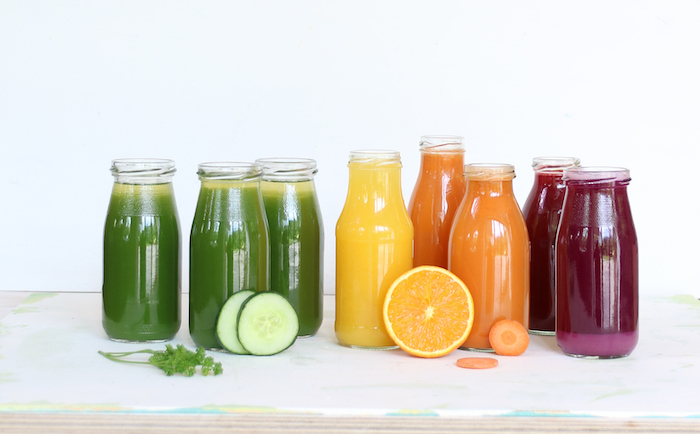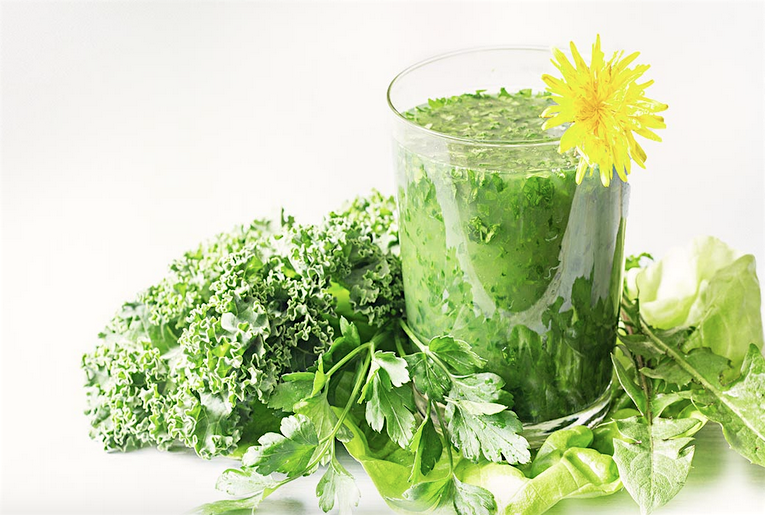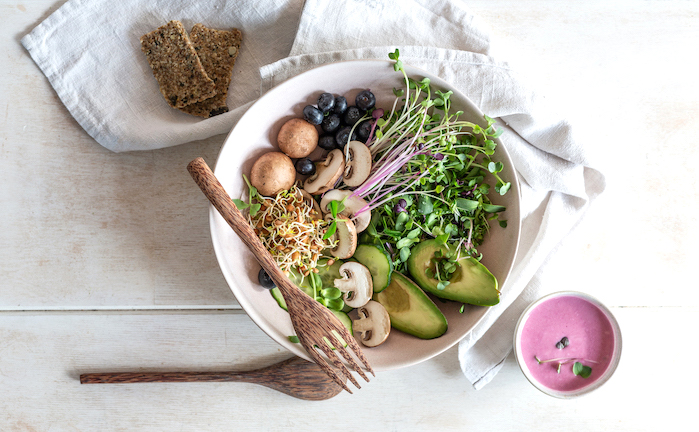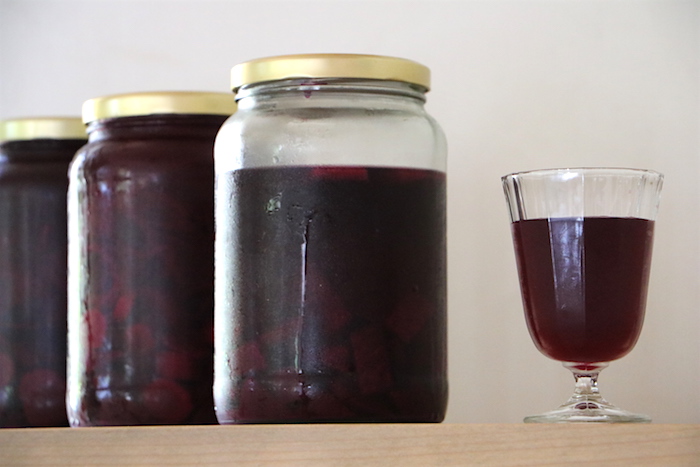Since many of Dr. Switzer’s recommendations are included in our training program to become a Holistic Nutrition Coach, we will present the essence of his work in this article.
Dr. John Switzer
Dr. John Switzer, a practicing doctor for 30 years and head of an Ayurveda center on Lake Starnberg, Germany, has been studying the strengths and weaknesses of different forms of nutrition for many years.
Today, he’s one of the most established specialists in the field of plant-based nutrition. His experiences show that the raw vegan lifestyle in combination with local wild plants provides optimal nutrients and can offer true satiety. In order to be able to successfully treat degenerative diseases and cancer in particular, Dr. Switzer developed his wild plant vital food therapy.
The focus of his work is on the topics of detoxification and cleansing, stimulating the metabolism and mineralizing the body.
The basic therapeutic elements used are Gerson therapy, wild plant vital food therapy and the Panchakarma cure.

Gerson Therapy
Gerson therapy is based on three essential cornerstones:
- Nutrient supply
- Detoxification
- Metabolism stimulation and strengthening of the digestive fire
Nutrient supply
Dr. Gerson recommends a plant-based, low-carbohydrate, low-fat and low-salt diet that includes high amounts of vitamins, minerals, enzymes and phytochemicals. Since it’s difficult to obtain the required amounts of nutrients and vital substances through diet alone, the diet should be supplemented with freshly pressed juices. Every day, patients drink 13 glasses of 250 ml of freshly pressed juices made from organically grown fruits and vegetables.
Pressing breaks down the plants’ cellulose fibers, releasing nutrients and vital substances. Without much digestive effort, these can enter the blood very quickly and can ultimately be absorbed by the cells. The consumption of gluten-containing carbohydrates and animal protein should be avoided. Omitting pasta, bread, cakes and pastries as well as all dairy products and meat can significantly support the therapy.
Detoxification
The aspect of detoxification is just as important in order to strengthen the immune system and thus the body’s self-healing powers. Dr. Gerson recognized that a thorough cleansing of the liver and intestines is essential and that the liver plays a key role in eliminating toxins and waste products. Many patients suffer from a congested liver.
Consuming freshly pressed juices also has the effect of mobilizing stored toxins from the tissue. These then enter the bloodstream, are detoxified via the liver and the body begins to cleanse itself. As the main organ in the detoxification process, the liver needs special support.
Coffee enemas are also administered. These open the liver and bile ducts so that the flood of toxins released can be excreted.
Strengthening digestive fire and stimulating metabolism
An enzyme-rich diet in the form of lots of fresh food and fresh juices enables the metabolism to be activated.
Stomach acid and digestive juices are important for a good digestive fire. Many people produce too little stomach acid. As a result, digestive power suffers and important organic minerals, trace elements and amino acids cannot be sufficiently assimilated.
On the other hand, strengthening the digestive fire in the form of a diet low in protein and rich in bitter substances can increase the absorption of nutrients and create optimal conditions for the body’s healing processes. Hydrochloric acid capsules can be temporarily administered to strengthen stomach acid.

Wild Plant Vital Food According to Dr. Switzer
The fact that Gerson therapy has become less effective than it was during the 1950s has prompted Dr. Switzer to research tirelessly and get to the bottom of the causes. Today, Dr. Switzer sees the main reason for this change as the advancing industrialization of agriculture.
When Dr. Gerson started his juice cures, vegetables and fruit still came from single-variety seeds. Hybrid breeding was introduced later during the 1960s. Through breeding, the sugar content of fruits and vegetables such as carrots and beets was increased and the bitter substance content was reduced. In keeping with consumers’ purchasing desires, fruits and vegetables today taste sweeter and less bitter than older varieties.
In addition, it was found that the content of secondary plant substances in hybrid breeds is minimized many times over. This development doesn’t even stop at the organic sector. Around 80% of seeds now come from hybrid breeding, whose trade is dominated by three large, globally operating seed companies.
Health disadvantages caused by hybrid breeding:
- Because of the rapid growth of hybrid fruits and vegetables, fewer nutrients are absorbed from the soil.
- More and more fruits are seedless, but the seeds contain extremely valuable substances, especially antioxidants.
- Due to the lack of vitamins, minerals and bitter substances, hybrid fruits and vegetables are less cellularly satiating.
- Hybrid breeds contain more fructose and the content of phytonutriens is greatly reduced.
Since cancer cells rely on an abundance of sugar, it’s worrying to drink more sugary carrot and beet juice.
Today, Dr. Switzer adds important aspects to the Gerson therapy and uses it very successfully in his practice and Ayurveda clinic in Starnberg. He bundles as many curative measures as possible in order to be able to successfully combat cancer and degenerative diseases. Wild plants and fermented juices play a major role.
Essential Aspects of Wild Plant Vital Food Therapy
The wild plant vital food according to Dr. Switzer contains nutritional advice and measures that can be practiced by basically anyone who wants to lead a healthy life. It’s low in carbohydrates, with a raw food content of 80-90%, so that the abundance of nutrients such as biophotons, enzymes, minerals, vitamins and secondary plant substances is largely retained, and takes into account a low but optimal fat intake.
For degenerative diseases and cancer, therapy plans compiled by Dr. Switzer are used, which supplement the classic Gerson therapy with valuable measures.
Wild Plants
Local wild plants play a key role. Dr. Switzer has experienced that the Gerson therapy gains enormous healing power through the addition of wild plants. Wild plants contain a unique variety of nutrients and vital substances. The blood-purifying and blood-strengthening effects of chlorophyll should be especially emphasized. The wild plant juices and smoothies should not be too sweet, as an increased blood sugar level activates the release of insulin. Rather, the insulin level should be lowered. Less insulin means less inflammation and growth stimulus for cancer cells. Cancer cells have 20 times more insulin receptors than normal cells. If insulin reaches these receptors, the metabolism of the cancer cells is boosted and sugar is introduced into the tumor.
Use wild plants with Dr. Switzer’s application in:
- Freshly pressed wild plant juices
- Wild plant smoothies
- Wild plant salads and nutritional dishes
In Starnberg, Dr. Switzer gives lectures and facilitates wild plant hikes. Not every patient tolerates a wild plant diet equally – the digestive fire is often too weak. But it’s precisely the bitter substances in wild plants that promote the formation of digestive juices and gradually activate the digestive fire.
Recipes:
- Freshly squeezed juice
- Wild plant smoothie
- Wild plants salad

Sprouts
Sprouts are intended to additionally complement vital food dishes. According to Dr. Brian Clement, head of the Hippocrates Institute in Florida, sprouts contain around 30 times more nutrients than vegetables. Broccoli seedlings in particular show special anti-inflammatory and anti-carcinogenic properties. The sulfur-containing ingredient sulforaphane is the reason for this.
One spoonful of broccoli sprouts contains as much sulphoraphane as 500 grams of vegetables. In order to enjoy sulforaphane, extensive chewing is a prerequisite.
Dietary Fiber
Dr. Switzer sees great health significance in the microbiome. If the bacterial environment is in balance, optimal nutrient assimilation occurs as well as the important protection of the intestinal mucosa. The intestinal mucosa forms the boundary between inside and outside. This is where the decision is made about what’s absorbed into the bloodstream and therefore the inside of the body, and what’s not.
If the intestinal mucosa is unstable or even perforated (as is the case in leaky gut syndrome), undesirable substances such as toxins or undigested proteins can enter the bloodstream. The consequences of this are irritation of the immune system and the allergies and autoimmune diseases that occur more frequently today.
Fiber can provide enormous support to the bacterial environment:
Fiber is a polysaccharide and is only contained in plant-based foods. Although they’re indigestible, meaning they’re not digested in the small intestine and travel almost unchanged into the large intestine, they fulfill important functions in the body.
Fiber is a polysaccharide and is only contained in plant-based foods. Although they’re indigestible, meaning they’re not digested in the small intestine and travel almost unchanged into the large intestine, they fulfill important functions in the body.

Fermented Juices
A very essential element is fermented juices, which Dr. Switzer recommends instead of sugary vegetable juices. They’re probiotic and contain almost no sugar. The fructose from vegetables is completely broken down through fermentation.
Fermented juices taste full-bodied and have a lot of healing power. Preparation is explained in the article, “Fermented Juices”.
Dr. Switzer sees fermented juices and other fermented products, such as sauerkraut or fermented quinoa curd, as an optimal complement to wild plant juices and smoothies.
To be avoided are:
Sugar and gluten
Foods containing sugar and gluten such as cakes, sweets, pizza, pasta, chips, bread, and rice cause blood sugar levels to rise and the intestinal walls to stick together, preventing detoxification. Products that contain sugar, wheat, rye, spelt or barley should therefore be avoided.
Raw cuisine provides a wealth of delicious alternatives. Small amounts of lentils, chickpeas, beans, pumpkin, sweet potatoes, quinoa, buckwheat and millet can be cooked to complement raw dishes. A high insulin concentration plays an important role not only in cancer, but also in cardiovascular diseases, adult-onset diabetes, inflammation, dementia and neurological diseases.
Animal protein
An oversupply of protein, as is quickly the case through consumption of animal products, leads not only to deposits in the connective tissue and the walls of blood vessels, but also to acidification of the body. Both aspects are clearly counterproductive to healing and regeneration.
Salt and fats
A therapeutic goal is also to minimize sodium and instead flood the body’s cells with organic potassium. Salt blocks cell detoxification. Potassium is said to promote a healthy, aerobic metabolism in cancer cells. When it comes to optimal nutrition for degenerative diseases or cancer, you should first avoid all fat and then pay attention to a low-fat diet.

Ayurvedic Panchakarma Treatment
Dr. Switzer has been running an Ayurveda clinic in southern Germany for 25 years, where he combines wild plant vital nutrition, constitutional homeopathic treatment and Ayurvedic applications and offers them in the form of the Panchakarma cure.
The main aim of the Panchakarma treatment is purification through a comprehensive detoxification of the liver, kidneys, gastrointestinal tract and body fluids (blood, lymph) and a subsequent change to a lively diet with lots of green leafy vegetables containing chlorophyll, sprouts and fruits.
The essential steps of the Panchakarma treatment are:
- Determination of constitution
- Pre-cure – vegetable juice fasting
- Main treatment – intestinal cleansing
- Change in diet
Ayurveda – Raw food
How does an Ayurvedic doctor come to raw food?
Dr. Switzer’s experience has shown that a state of superior health cannot be achieved with a predominantly cooked diet. The most important thing is a high level of mineralization in the body. Too many nutrients are lost through cooking.
Raw foods contain an abundance of living enzymes, vitamins, minerals, biophotons and chlorophyll. For patients, the ratio of around 80% raw food (through wild plants, sprouts, probiotics, green leafy vegetables, seeds, nuts, fruit, etc.) and 20% cooked food, for example in the form of quinoa or lentil dishes, is often very constructive. Even small amounts of animal fat in the form of raw milk butter can act as a catalyst and stimulate metabolism.
Would you like to join our unique, based on nutritional sciences and practice-oriented training program for gaining a high level of health?
We are more than happy to inform you about our training program on our website!




0 Comments